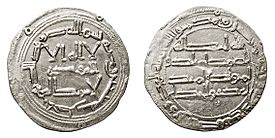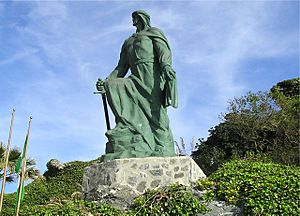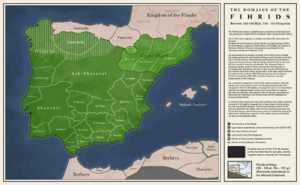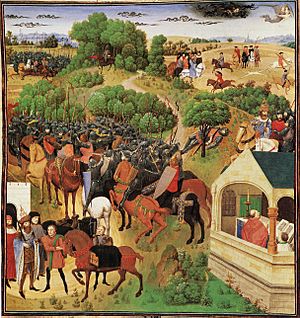Abd al-Rahman I facts for kids
Quick facts for kids Abd al-Rahman I |
|
|---|---|
| Saqr Quraish | |

Dirham coin of Abd al-Rahman I
|
|
| 1st Emir of Córdoba | |
| Reign | 15 May 756 – 30 September 788 |
| Predecessor | Yusuf ibn Abd al-Rahman al-Fihri (as governor of al-Andalus) |
| Successor | Hisham I |
| Born | 7 March 731 Damascus, Syria, Umayyad Caliphate |
| Died | 30 September 788 (aged 57) Qurtuba, Al-Andalus, Emirate of Cordoba (present-day Spain) |
| Consort | several; including Hulal |
| Issue | Sulayman Omar Hisham I Abdullah |
| Dynasty | Umayyad |
| Father | Mu'awiya ibn Hisham |
| Mother | Raha |
| Religion | Sunni Islam |
Abd al-Rahman I (born March 7, 731 – died September 30, 788) was a very important leader. He founded the Umayyad dynasty in Iberia, which is now Spain and Portugal. This dynasty ruled for almost 300 years.
Abd al-Rahman was part of the Umayyad royal family from Damascus. His family was overthrown by the Abbasids in 750. He then escaped and created a new government in Iberia, breaking away from the Abbasids.
People also called him al-Dakhil ("the Entrant") because he entered Iberia. Another nickname was Saqr Quraish ("the Falcon of Quraysh") or "the Falcon of Andalusia."
Contents
Abd al-Rahman's Life Story
How Abd al-Rahman Escaped Damascus
Abd al-Rahman was born near Damascus in 731. His father was Prince Mu'awiya ibn Hisham, and his mother was Raha, a Berber woman. When he was 20, the Abbasids overthrew his family. They tried to kill all Umayyads.
Abd al-Rahman, his brother Yahya, his young son Sulayman, and some sisters fled Damascus. They traveled towards the Euphrates River. Abbasid horsemen chased them, trying to find and kill the prince.
At one point, Abd al-Rahman and his companions had to jump into the Euphrates River to escape. The horsemen promised no harm if they returned. Yahya turned back, but he was quickly killed. Abd al-Rahman and his loyal helper, Bedr, were the only ones left.
Abd al-Rahman's Journey as an Exile
After escaping, Abd al-Rahman and Bedr traveled through Palestine, the Sinai Peninsula, and Egypt. He had to hide to avoid being caught. He planned to go to northwestern Africa, where his mother's people, the Berbers, lived.
The journey through Egypt was dangerous. The governor of that region, Ibn Habib, was once friendly to Umayyads but then turned against them. Abd al-Rahman and Bedr had to keep moving.
In 755, they reached modern-day Morocco. Their next step was to cross the sea to al-Andalus (Iberia). Abd al-Rahman wasn't sure if he would be welcomed there. Al-Andalus was in chaos, with different groups fighting for power.
Abd al-Rahman hoped to find support from some Syrian soldiers who had been loyal to his family. Bedr crossed the sea to make contact. He found some commanders who agreed to help. They also got support from other groups who wanted a new leader.
Abd al-Rahman then sailed to al-Andalus. He landed in Almuñécar in September 755. Some local tribes tried to stop him for money, but he managed to escape them.
Fighting for Control of al-Andalus
When Abd al-Rahman landed, he was welcomed by his supporters. Many people came to meet him in Malaga. News of his arrival spread quickly.
The current ruler of al-Andalus, Emir Yusuf al-Fihri, and his general, al-Sumayl, were worried. They tried to make a deal with Abd al-Rahman, but he wanted to rule.
Luckily for Abd al-Rahman, a rebellion broke out in Zaragoza in the north. Al-Fihri and al-Sumayl went to stop it. This gave Abd al-Rahman time to gather more support. By March 756, he took Seville peacefully.
Al-Fihri's army was defeated in the north, and he turned back to face Abd al-Rahman. The two armies met near Córdoba. Abd al-Rahman's army was hungry, but he inspired them. He even swapped his fine horse for a mule to show he was ready to fight alongside his men.
Abd al-Rahman led his army into battle. They fought hard and won a great victory. He marched into Córdoba as the new ruler.
Al-Fihri tried to fight back again but was defeated. He was eventually killed in Toledo. His head was sent to Córdoba as proof of Abd al-Rahman's victory. Al-Sumayl, al-Fihri's general, was also captured and killed. This helped Abd al-Rahman secure his rule.
How Abd al-Rahman Ruled
Abd al-Rahman became the first Emir of Córdoba. He invited other Umayyad family members and loyal followers to al-Andalus. He gave them important jobs because he trusted them. His son Sulayman, whom he had left behind, finally joined him.
In 763, an Abbasid army invaded al-Andalus. The Abbasid caliph, al-Mansur, wanted to remove Abd al-Rahman. The Abbasid army was much larger, with 7,000 men.
Abd al-Rahman and his army went to Carmona and were surrounded. After two months, with food and water running out, Abd al-Rahman decided to make a bold move. He chose 700 fighters and led them out of the city gates. They surprised the Abbasid army and defeated them completely.
The heads of the Abbasid leaders were sent to the Abbasid caliph, al-Mansur. When he saw them, he supposedly said, "God be praised for placing a sea between us!" He respected Abd al-Rahman so much that he called him the "Hawk of Quraysh."
Even after this big victory, Abd al-Rahman had to keep fighting rebellions. Different groups and even some of his own family members tried to take power. But Abd al-Rahman always managed to defeat them and keep control.
Challenges in the North
Zaragoza in the north was a difficult city to control. In 777, some leaders there met with Charlemagne, the powerful Frankish king. They wanted Charlemagne to help them against Abd al-Rahman.
Charlemagne's army came to Zaragoza, but the local leader, Sulayman, changed his mind and wouldn't let them in. Charlemagne then left, and his army was attacked by Basque rebels in the Pyrenees mountains.
This allowed Abd al-Rahman to deal with Zaragoza. In 779, he offered the governorship of Zaragoza to Husayn, one of Sulayman's allies. Husayn killed Sulayman and took the job. However, Husayn soon tried to make Zaragoza independent.
In 783, Abd al-Rahman's army attacked Zaragoza with many siege engines. They broke through the city walls and took control. Abd al-Rahman made it clear that Zaragoza would remain part of his rule.
Abd al-Rahman's Achievements and Death
Building and Society
After many conflicts, Abd al-Rahman worked to improve al-Andalus. He built roads, improved water systems, and started building a grand mosque in Córdoba. This mosque, the Great Mosque of Córdoba, began construction around 786.
Abd al-Rahman also created a strong government and a large standing army of about 40,000 soldiers, mostly from North Africa. He knew he needed a loyal army to keep peace in the land.
He allowed Christians and Jews to practice their religions in exchange for a tax called jizya. Many people in al-Andalus eventually became Muslim, though some scholars say this happened more slowly over time. There was a lot of freedom for different groups to interact. For example, a granddaughter of a Visigoth king married a Muslim man.
Abd al-Rahman I successfully fought against powerful enemies like Charlemagne and the Abbasids. He created a new Umayyad dynasty in al-Andalus, ensuring his family's survival and leading to the later Caliphate of Cordoba.
His Death
Abd al-Rahman died around 788 in Córdoba. He was likely buried under the site of the Great Mosque. His chosen successor was his son, Hisham I. Abd al-Rahman's family continued to rule al-Andalus for many generations, reaching their peak under Abd al-Rahman III.
Abd al-Rahman's Family
Abd al-Rahman's mother was a Berber woman from the Nafza tribe. He found safety with her people after his family was killed in 750.
He married a Spanish woman named Hulal, who was the mother of his son Hisham. Abd al-Rahman had several sons:
- Sulayman (745–800): He was governor of Toledo.
- Omar (died before 758)
- Hisham I (757–796): He became the next Emir of Cordoba.
- Abdallah
Famous Nicknames
Abd al-Rahman was known as al Dakhil ("the Entrant"). But his most famous nickname was Saqr Quraish ("The Falcon of the Quraish"). This name was given to him by one of his greatest enemies, the Abbasid caliph al-Mansur.
The story goes that al-Mansur asked his courtiers who deserved the title "Falcon of the Quraish" (meaning the bravest and most important leader of the Quraysh tribe). His courtiers suggested him, but al-Mansur disagreed. They suggested other great leaders, but he still said no. Finally, al-Mansur said that Abd al-Rahman was the true "Falcon of the Quraysh" because he had escaped danger, crossed deserts and seas, and built a new empire all by himself.
See Also
 In Spanish: Abderramán I para niños
In Spanish: Abderramán I para niños
- Timeline of the Muslim presence in the Iberian peninsula
- Abbasid Revolution
- al-Andalus
- Caliphate of Córdoba
- Abd al-Malik ibn Umar
- Sara al-Qutiyya





